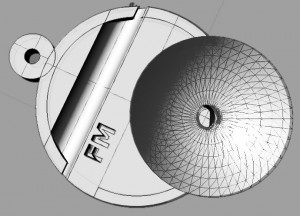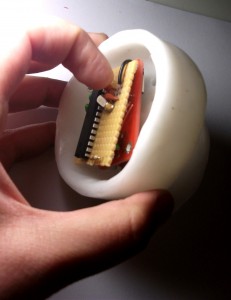what if sounds would be souvenirs instead of pictures?
Home
Social
Calendar
Phases
For my final project of physical computing I decided to build a robotic arm, controlled by
six standard-sized servo motors. The idea was to control servos of the robotic arm with an
arduino code, using a serial communication with a bunch of different softwares such as
Processing or Max MSP.
As a basis for building a robotic construction I used an open-source robotic arm from
Oomlout. The structure of the robot consists of 26 parts, which need to be laser-cut, either
from a 3 mm thick wooden panel or an acrylic glass sheets. Parts are then assembled, using
3mm screws and nuts.
materials required: 3mm thick sheets of acrylic glass or wood, screws and nuts (3mm),
electronics: arduino board, breadboard, jumping wires, servo extension cables,
6 standard servo motors (4.8-6V, 6 kg/cm, 40 grams), external power supply for servo motors
(25 W, 5V, 5 Amp)
software: Arduino+servo library, Max msp (for serial communication and control interface )
other software possibilities for serial communication and servo control: Processing, Open CV…
Robotic Arm Video link.
OK, so I have been developing the work around the live radio over the last month. When I say last “month”, you assume that I am now done with three radio projects instead of one, but unfortunately, that’s not quite the case. My main interest in this project is to create a complete system composed of sound transmitters and receivers that are mobile and work efficiently together.
I have been following the checklist I set for myself on the last post, which starts by shrinking the circuit. Before I start, I should tell you that I did a lot of miles in this project. Distance miles. Went to the airport twice to pick up my DHL shipments, where in theory I paid for a door to door delivery, then ended up skateboarding between airport terminals. ![]()
Back to shrinking the circuit, I ordered AtTiney84 from Farnell (and picked it up from UPS office in Hospitalet!). The pieces are really tiny as you see on the left of the right picture, but they don’t support all arduino functions, which is what I discovered after getting them. Of course! So my other alternative was to use the Atmega328P, which is the same chip of the arduino.
 I don’t have enough expertise in any of these details, but the web is a blessing. Check MIT references here and and arduio pages. So, I burnt the bootloader for the new chips using 2 arduinos, then wired the chip on a breadboard and uploaded sketches using arduino as ISP. Those are very interesting and cheap methods (since we don’t use and external programmer) for programming the chips. Then I tested the transmission pieces with the receiver pieces and they work together perfectly. For a newbie, that was a lot of learning and loots of troubleshooting! But awesome, now I can save size and money (the chip is 2.5 EUR while an arduino is 25 EUR! –big difference) and run the piece independently using 2 (3V) batteries. So that operation is done and tested, I needed to complete soldering the standalone board with the FM shield, and pack this is a nice 3D printed casing.
I don’t have enough expertise in any of these details, but the web is a blessing. Check MIT references here and and arduio pages. So, I burnt the bootloader for the new chips using 2 arduinos, then wired the chip on a breadboard and uploaded sketches using arduino as ISP. Those are very interesting and cheap methods (since we don’t use and external programmer) for programming the chips. Then I tested the transmission pieces with the receiver pieces and they work together perfectly. For a newbie, that was a lot of learning and loots of troubleshooting! But awesome, now I can save size and money (the chip is 2.5 EUR while an arduino is 25 EUR! –big difference) and run the piece independently using 2 (3V) batteries. So that operation is done and tested, I needed to complete soldering the standalone board with the FM shield, and pack this is a nice 3D printed casing. 
The printing thing took me over a couple of days of troubleshoot, and logistic problems, and other random stuff, so for the final presentation, realistically, I don’t think I will be able to finish those pieces (still need to solder the boards as well!), but I made a quick up mock up using polypropene, to give an idea of how this should look like notice the parabola at the microphone outlet, I would like to test this idea in the future using different geometries and materials.
 So for the demo, I guess, I will build a unit for the receiver, and keep the transmission units arduino dependent, just to illustrate the idea. I would have loved to finish everything . . . but time is fast.
So for the demo, I guess, I will build a unit for the receiver, and keep the transmission units arduino dependent, just to illustrate the idea. I would have loved to finish everything . . . but time is fast. P1015305 from rafael vargas on Vimeo.
P1015315 from rafael vargas on Vimeo.
Glove osc Update from rafael vargas on Vimeo.
The drum gloves comes from the idea of converting movements and sounds from physical and electronic instruments into a portable ‘surface free’ sound producer. Instead of hitting a specific surface with your fingers that outcomes in some type of sound, the drum gloves will provide you with surfaces will be on your fingers. The concept is that when you wear the gloves, you can hit any surface and produce midi signals that can be sent to your mobile phone, tablet or computer and use any virtual instrument. Assign some instruments and start playing.
Changes made for the final
Smaller components were needed. Also to get rid of the cable that goes to the computer. Arduino Fio solves those problems. It’s small and you can connect a 3v lithium battery to it. The wi-fly adds the capability of communication via Osc Protocols with any device that can handle it: Computers, tablets, mobiles. . .
Now, this time the prototype needed a smaller circuit board because the glove is smaller. A custom circuit board was milled @ the fablab for that.
The code got a lot more complicated than with the waveshield. Osc packets had to be send via wifi using the ip addres of the device that was going to be targeted. To test messages were sent to max msp. These messages had to be activated by the pressure in the finger sensors.
Applications, benefits and relations between: 1/Intelligence,
2/Disabilities and 3/Health.
Smart citizen platform/system could convert in a way of
relevant information. It could improve the quality of life as
well as the citizen security.
1/Smart citizen platform could be assistant tool for police and
intelligence services. It could convert in a special data capture
for solving criminal acts and robberies. In this sense, smart
citizen platform could become in an accurate tool. It could
inform about temperature changes, moisture changes or light
changes.
2/Smart citizen platform could be assistant tool for people with
disabilities. A symbolic examples could be: A person with a
visual disabilities could Know the weather in your neighborhood
using the smart citizen platform.
Somebody with an olfactory handicap could not detect some
strange smell as well as a strange situation. The fire smell could
be detected by the smart citizen sensors. In this way, it would
be a skillful informative tool for people with disabilities.
3/Smart citizen platform could be assistant tool for nurses and
doctors. They could know the moisture, temperature and other
city-life concepts. Then nurses and doctors could advise about
life habits, life behaviour or adequate travels.